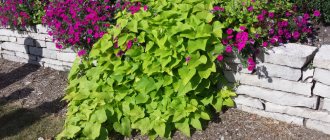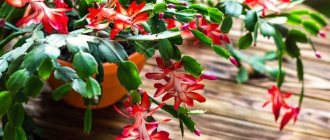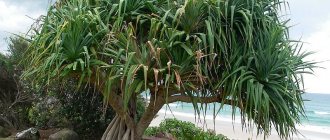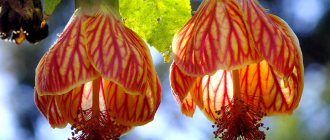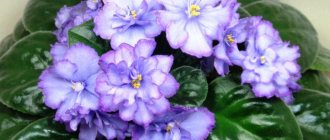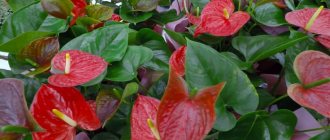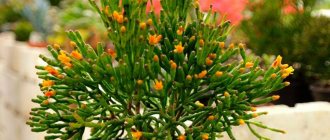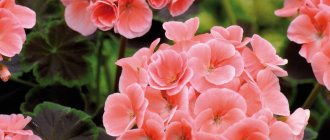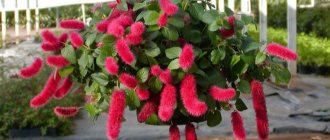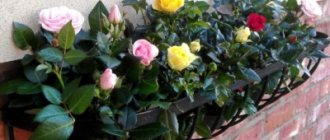Achimenes is developing intensively. It is quite easy to grow it at home. A bush up to 60 cm high can be formed in one growing season. The perennial plant blooms in waves, forming velvety, bright bells from June to September. After this, the aboveground part dies, and in the spring it is reborn from the rhizome.
Be sure to pay attention to such wonderful plants as Columnaea and Saintpaulia.
| Achimenes is developing intensively. |
| It blooms in waves, forming velvety bright bells from June to September. |
| The plant is easy to grow, there are some minor difficulties. |
| The plant dies back every fall and grows back in the spring from old rhizomes. |
Types of indoor Achimenes plants and descriptions of their flowers
According to the type of growth, Achimenes are:
- Erect.
- Ampelous.
- Semi-ampelous.
Achimenes as an indoor flower can grow both straight and in an ampel. In the first case, the branches and shoots grow upward or sideways, and in the second, on the contrary, downward, and the plant sits in special flower pots. The third option is intermediate in terms of the direction of shoot growth.
Flowerpots are flower pots of medium diameter with a special mount for hanging. Such containers are good for climbing or bushy plants. In addition, they perfectly decorate the room without taking up space on the windowsill or table.
The description of the structure of Achimenes should begin with its main advantage - flowers. In shape they are similar to a “pipe” or “gramophone” with different petals - from rounded to “torn” edges. It blooms in summer with white, yellow, pink, purple or blue flowers. There are varieties with spotted, striped or two-colored inflorescences. All appearance features vary depending on the type and variety of the plant.
Features of Achimenes
Achimenes is classified as a member of the Gesneriaceae family. This is a herbaceous perennial native to South and Central America. It has erect or drooping shoots that are weakly branched. In color they can be dark green or reddish. Their roots are scaly in the form of rhizomes, similar in appearance to fir cones.
The leaves are petiolate, oblong in shape, have jagged edges and a sharp end. The color can be green, dark green, with a pink or purple tint. The lower plate is pubescent.
Did you know? The largest sculpture of fresh flowers in the world was made in Ecuador in 2022. Almost 564 thousand roses were spent on its creation. 1.5 thousand local residents worked on it.
Achimenes blooms for a long time - from May to October. When favorable conditions are created and quality care is provided, it can bloom twice a year. Its flowers are paired or single, axillary, have 5 petals and a tube-shaped corolla.
Achimenes are suitable for decorating various interiors. They are grown on window sills, shelves, in flowerpots and hanging baskets as hanging and cascading plants.
Types and varieties of Achimenes: photos, names and descriptions
For detailed information, look at the list of names of popular varieties of Achimenes with the photos presented:
"Abendrot".
"Abyss"
"Adelaide".
"Alaska Dream"
"Amie Saliba"
"Amour"
This is not the entire list of varieties that deserve special attention; in fact, there are a large number of them. And all of them captivate plant growers with their unique flowering.
Despite the diversity in inflorescences, the plants are almost identical in structure. They have soft leaves with a ribbed, veiny surface and a pointed tip, and branched stems that fall slightly to the bottom.
Homemade varieties of Achimenes flowers have an unusual structure of the root system. They are characterized by rhizomes covered with scales, similar to small fir cones, with the help of which the plant reproduces. These scaly shoots are called rhizomes, and they are modified parts of normal roots.
The flowering period begins at the beginning of summer and lasts until autumn. And in winter, a dormant stage begins when the plant goes into hibernation.
Look at an example of the root system of a domestic achimenes flower in the photo below, which is presented for your reference:
There are many types of flowers known in indoor floriculture, but only a few of them are distinguished by their special participation in the development of varietal diversity of the crop. The main types of the Achimenes plant are:
- Long-flowered.
- Large-flowered.
- Mexican.
- Erect.
- Sweet.
- Lvinozevy.
- Snow-white.
- Prostrate.
It was they who served as the foundation for the emergence of the most popular and widespread varieties of this unique home flower.
Photos and a brief description of Achimenes species are presented below for your study.
Long-flowered Achimenes is a medium-sized species, reaching a height of 30 cm. The foliage and shoots are light green in color, the flowers are mostly light, reach a diameter of 4.5-5 cm, and grow one at a time.
Large-flowered Achimenes is a large species, capable of growing up to 0.6 m. The flowers are large - up to 7 cm in diameter, the leaves are slightly larger - up to 10-11 cm. It has a dark green bright color of foliage and shoots, flowers are usually larger rich colors. The main characteristic feature of the species is a small hollow formation at the base of the flower.
Indoor plants of Mexican achimenes reach a height of up to 35-45 cm, have straight shoots and medium-sized inflorescences. The bells are blue and purple with a white center with a yellow stripe. The leaves are dark green, oval shaped with one pointed end.
The erect species is quite large - up to 45 cm, with reddish shoots and small scarlet inflorescences. The main feature of the sweet species is the presence of a subtle delicate aroma. A medium-sized plant with light, small flowers (up to 4 cm in diameter) with a bright yellow core.
The flower of the lion's cape species, Achimenes , is small in size with a yellow center and a red pattern on it. The leaves are light green in color with a light downy coating.
The snow-white appearance has corrugated sheets with “torn” edges. The inflorescences are light white with a deep throat. The shoots are slightly red in color.
Varieties of indoor Achimenes are highly decorative. But some of them are especially unique. All thanks to the shapes and color palette of the inflorescences, which captivate all lovers of home vegetation.
Below are photos of upright varieties of Achimenes and their brief description.
“Milk and Honey” - the variety has straight shoots and medium-diameter flowers, with a milky terry corolla and a purple spot in the core. This is a miniature plant with very abundant and lush flowering.
"Kitty Elizabeth" - has straight-growing shoots, large, slightly double white inflorescences with blue tints. Its core is yellow, and the edge of the bud is wavy. The foliage is light green in color.
“Alaska Dream” - the variety has upright growing shoots and large, snow-white double flowers in diameter. The foliage is rich green with a zigzag edge.
You can see by looking at the photo that the Achimenes variety “Ballerina” has a bright and spectacular appearance:
They have straight-growing shoots and inflorescences of red-burgundy color. Their core is yellow, and the foliage is dark green with a reddish rim along the edge.
“Golden Lady” has straight shoots and medium-diameter flowers of a creamy color with one “extra” petal. Terry foliage, dark green.
"Raspberry Ripple" - straight, dark-colored shoots form a miniature plant. The flowers are delicate pink with a bright red edge and a yellow center.
One of the new varieties of Achimenes of British selection is called “Double Yellow” and amazes with its smooth coloring of yellow shades. These are large double flowers with a light yellow center and an orange border at the tips of the petals.
“Belas Memȯrias” - this variety has straight shoots and white-pink flowers with a purple center and fringed edges. Foliage is light green tones.
"Bird of Paradise" is a plant with slightly drooping shoots and dark leaves with a burgundy interior. The flowers are small, crimson in color with a yellow-brown-lilac throat in the center.
The flower of the stunning Achimenes variety "Tatjana Savсhuk" is suitable for cool rooms. It has a straight shoot structure and large flowers with a lilac corolla. The petals are wavy around the edge and yellow in the center.
“Blue Bird” is a flower variety with a bright blue color and large inflorescences. The structure of the shoots is straight, the petals are wavy with a white core and brown spots. An adult plant grows small in size - up to 30 cm in height.
Reviews from amateur gardeners about growing Achimenes
I first became acquainted with this plant about 25 years ago; it grew at our work, but no one knew where it came from or what its name was.
Over time, I found out the stranger’s name - Achimenes. We haven’t met since then; for some reason not a single flower shop sold it. And only in January of this year I found an online store that sold rhizomes (rhizomes) of varietal Achimenes. Out of impatience, I decided to pick it up at home. In the cold, on the crossroads, I went God knows where, to some village near Bronnitsy for the long-awaited flower. The price, by the way, be healthy, is 200-250 rubles. for a rhizome the size of a lemon grain, but it suited me. I took it home “in a corset” so as not to freeze the purchase. I bought 4 varieties, the fifth was given as a gift. In winter, Achimenes sleeps, the entire above-ground part dies. I planted rhizomes in pots in February (planting depth about 2.5 cm), waited a long time for tiny sprouts (appeared in April), slightly moistening the soil. When it got warmer, I took it out onto the balcony, protecting it from the scorching sun. Flowering began at the end of May. Especially in hot weather, you need to water generously, but not overwater. Fertilized with a preparation in the form of sticks for flowering plants. Now two are blooming, and three are still very small and without buds, apparently, I got very small roots, but, most importantly, they are growing. Flowering will last until October, but as soon as the temperature drops to +15, Achimenes will stop blooming and begin to prepare for winter - you will need to reduce watering and do everything again (sleep in almost dry soil until February). A very beautiful and interesting flower, especially convenient for those who do not have enough space on the windowsill in winter. Svetlana Yurievna
I met Achimenes about 3 years ago.
Initially I had only 10 varieties, but now my collection numbers at least 50. I fell in love with this flower immediately and it seemed like forever. How many colors (blue, white, yellow, red, brown and multi-colored with different borders), shapes, varieties does this unusual flower have? Achimenes come in ampelous and erect forms. This is a decoration for my loggia and window sills. Grows from spring to cold weather. I plant 3 rhizomes in a 12 cm pot in the spring (late February - early March) and last year the last one bloomed even in December. Just like gloxinia, they go dormant in winter. The pots can be removed and left until spring. You can dig up rhizomes (nodules) and store them in vermiculite. If not properly cared for in winter, the rhizome can dry out; store it in a cool place. It propagates vegetatively very easily and such roses bloom much earlier than a plant from a rhizome. It is advisable to propagate the plant in the spring, because... the plant blooms in May-June. Blooms daily until cold weather, without going dormant. You can propagate in water, soil, or plant valuable varieties in a peat tablet. The main thing is not to overwater the plant in spring and summer, otherwise the rhizome will rot. Experiment and this plant will give you a waterfall of different colors. I highly recommend for breeding. Julia37 https://irecommend.ru/content/vodopady-tsvetov
Oh, well, this is such a sweet little flower) Tropical, Brazilian, one might say)) Disappears in winter, appears in spring, blooms in summer and delights you until the end of the season with its rich purple flowers - lights.
True, it comes in different colors, I have seen red achimenes, but I prefer lilac-violet, like mine. In general, I have a weakness for flowers in blue shades, since they are quite rare in nature. Achimenes belongs to the same family as everyone's favorite house violets - the Gesneriaceae family. Its stems and leaves are softly pubescent. But in the fall, the entire growing season ends and only small scaly nodules remain in the pot. They do not need to be watered until February, and it is better to place the pot in a cool, dark place. In the spring, the sprouts will hatch - then start watering. In a pot, achimenes forms like a casually scattered bouquet - it is a very picturesque sight, it has thin long stems with drooping bells of flowers. If you pinch the spring shoots, you will end up with a very lush bush that will delight you until mid-autumn. The petals of the flowers are very much turned outward and the diameter of the flower turns out to be about 1–1.5 cm. This is quite a lot. But I saw in good conditions, in a greenhouse, exactly the same variety with a gigantic flower size! This is what suitable humidity and a spacious pot mean. The soil for this plant should be light, with a mixture of sand. Stagnation of water can be harmful, just like violets and all Gesneriaceae, so drainage is recommended. Place away from direct sun. But, in general, I consider it an unpretentious flower, it has been living with me for about 20 years. It takes a lot of effort to grow it)) ElzaTriole https://otzovik.com/review_614702.html
This flower is very whimsical, for me it grew up to 30 cm, the stem of the flowers was like a coffee saucer, the main thing is not to overfill it, I really like it, I barely found the root of such a flower, I hope it will grow to its previous size.
I really like this flower, I hope I have the strength to grow it to its previous size, the flower pleases with its colors, I like its beauty and appearance, having such a flowering plant at home, you enjoy every day of its flowering, propagating this flower is not very difficult, but when to propagate whole plantation, it is impossible not to admire these beautiful plants, the acquisition is worth it, whoever doubts it is not worth it, this flower will delight you with its beauty. Jula43 https://otzovik.com/review_1181898.html
Achimenes is a very beautiful and graceful plant that blooms profusely and brightly all summer. They can decorate an apartment, but the flower feels best in the fresh air. Modern varieties of Achimenes are magnificent; there are plants with both simple and double flowers of various colors. Achimenes is very unpretentious, so even a novice gardener can handle caring for it.
Ampel and semi-ampel varieties of Achimenes flowers
It is worth starting to describe the ampelous varieties of indoor Achimenes with the “Abendrot” variety. Amazing flowers resemble the shape of open rose buds. Large double inflorescences are painted in purple and pink tones. The leaves are slightly terry, light green in color.
"Adelaide" - has long shoots and large blue-blue flowers, the core is yellow. The leaves are light pink on the inside.
Pay attention to the ampelous Achimenes variety called “Little Beauty”: its photo is presented below.
As the shoots grow, they form a ball with a large number of large, bright pink pipe flowers. This variety is especially popular among plant admirers.
"Kim Blue" is a medium-sized plant that blooms profusely. Bright purple five-petaled inflorescences of large size frame long shoots. The foliage is red on the reverse side.
The description of semi-ampelic varieties of Achimenes should begin with the expressive variety “ Amour ” bred by S. Saliba. It stands out for its unusually bright pink flowers of small size. There are red-brown spots and stripes in the middle. Grows small in size.
'Dame De Paris' has medium-sized white flowers with a pink edge. The core is bright yellow and the leaves are dark green. Blooms long and profusely.
Plant differences
Achimenes differ in the following characteristics:
- Type of shoots - there are types in which they grow upward (erect), and there are those in which they droop (ampeloid).
- Bush height - various species, varieties and hybrids form bushes with a height of 30 to 50 cm.
- The size of the buds is small, medium and large, reaching a diameter of 2.5 to 6 cm.
- The color scheme of the buds - the petals can be pink, purple, white, red, yellow, orange.
- Level of doubleness of flowers - petals are smooth, semi-double and double.
- Flower shape - during flowering, round, long, bell-shaped buds are formed.
Proper care of Zaachimenes (with video)
Achimenes are not very demanding to care for and grow. By creating optimal conditions for their growth, abundant and regular flowering is ensured.
The flowering season for this plant is summer; in winter it “rests” and gains strength for the growth of new shoots and flowers. At the end of February and beginning of March, the flower “awakens” and the first shoots appear from the rhizomes. In its natural environment, Achimenes can bloom all year round, but in harsher cold climates, the heat-loving plant prefers to shed all its foliage and twigs and overwinter in a dark, dry place.
To care for achimenes at home, you need to pay attention to a number of environmental factors:
- Lighting.
- Temperature.
- The soil.
- Feeding.
- Watering.
- Trimming.
- Transfer.
The location likes light and warm, but not sunny, from spring to autumn. As with any indoor plant, light plays an important role. In a room that is too dark, the flower will experience a lack of lighting, and the process of photosynthesis will be absent, which will lead to the flower becoming faded and weak. Important! Avoid direct sunlight! If exposed to direct sunlight, the greens will dry out and become brittle. Therefore, the most favorable side for growing domestic achimenes is eastern or western. There will be no strong shadow or scorching rays, but gentle diffused light will contribute to long-term flowering and the vitality of the flower. During the dormant period, lighting requirements change. For wintering, you should remove the pot with the plant to a darker place.
Favorable temperature: +20…+25 °C. This is the most suitable temperature range for growing Achimenes flowers at home. It’s good to place pots on the veranda, balcony or terrace in the summer; they feel great in the fresh air. But it is important to prevent cold drafts from occurring; they have a detrimental effect on the health of the plant and can cause its disease and death, because This is a heat-loving type of home vegetation. During the dormant period, the temperature requirements are slightly different. The most favorable temperature range for wintering is +13…+15 °C. Under such conditions, the tubers will be well preserved and will not begin to germinate before the due time.
Another very important condition for growing Achimenes flowers is the type of soil and fertilizing.
- Recommended substrate: flower soil mixture.
- Time to fertilize: fertilize until the end of July.
For this plant, soil drainage plays a very important role, because... if its ventilation is insufficient, the humidity level will be too high, and there will be a risk of fungal infections due to stagnant water. The soil should be quite loose. Its components should be leaf, turf and sandy soil in a ratio of 3:2:1. Peat and humus soils can be added as an additive. Such mixtures can be purchased ready-made in specialized stores. Briquettes are sold with the mark “For decorative flowering plants.”
To make caring for Achimenes at home easier, watch the video below:
It describes in detail what factors influence the life of the plant and how to properly care for it in order to grow a flowering decoration for the home.
Lighting
Despite the fact that in general Achimenes is a light-loving plant, the brightness and intensity of the light flux largely depends on the plant variety. Varieties with dark leaves need more light than variegated varieties, but Achimenes do not tolerate direct sunlight. At noon, the plant must be shaded - this will help avoid burns on the leaf blades.
Achimenes cannot be considered too capricious a houseplant
Achimenes are very popular among house plants.
How to care for Achimenes: feeding and watering
To grow a healthy achimenes and properly care for it at home, take care of feeding it. It should be produced only during the period of active growth. And you should start feeding 1.5 months after the first sprouts from the tuber appear. You can purchase ready-made mixtures for fertilizing the soil of flowering plants at flower shops.
Watering: Starting in September, reduce watering to allow the plant to slowly wilt. At the end of the flowering period, the plant enters a dormant phase, which makes watering unnecessary. During wintering, excess moisture will only do harm, so lightly moistening the edge of the soil once a month will be quite enough. But for the flowering period this is catastrophically not enough. Here, abundant and regular watering is necessary to avoid drying out of the soil. It is best to do this 1-2 times a week with settled water at room temperature. Do not pour cold water under any circumstances, as this can cause shock and death to the plant. It is also allowed to humidify the air around the pot using a spray bottle - once a week.
Diseases and pests
If you carelessly care for a plant, it will be plagued by diseases and pests, as evidenced by unpleasant symptoms:
- spots on the leaves of Achimenes - from watering with cold water or excess sunlight (adjust watering, shade the plant);
- Achimenes flowers quickly fall off - excess light (move to the shade);
- Achimenes is deformed, leaves of Achimenes fall off - damage by pests (insecticides are used);
- Achimenes leaves turn yellow - decreased photosynthesis due to iron deficiency or watering with hard water (feed with fertilizer containing iron; settle water for irrigation, soften with citric acid - 0.2 g per liter of water);
- the leaves are brown and curl - a sharp change in temperature, keeping the plant in a cool, damp room (move to a dry, warm place, protected from drafts and temperature changes).
Achimenes is sometimes affected by pests: aphids, mealybugs, thrips, spider mites.
Wintering Achimenes: how to store a flower in winter during the dormant period
Pruning: Trim dry parts of the plant. When preparing Achimenes for the period of winter dormancy, it experiences the death of flowers and leaves. This is due to the shedding of excess ballast before the sleep phase. Dried parts will only burden the flower and deprive it of useful microelements, which will be very necessary for maintaining the life of the rhizome in winter. Therefore, it is important to remove all dried shoots with a twisting motion to alleviate the condition of the flower after the growing season.
As for replanting the plant, it should be regular - once a year in early spring. Over the entire growing season, the soil is depleted and no longer has the rich composition of microelements necessary for plant life. Therefore, once a year at the end of February it is necessary to update the soil, but this must be done before the “awakening” of the flower begins. The rhizomes should be left in the pot until the end of February and then replanted.
Place rhizomes in new pots so that they are covered by 2 cm with new soil. Place in a warm, bright (not sunny) place. Water with warm water, take care of artificial air humidification. It is best to spray the air around the pot with a sprayer 1-2 times a week.
The wintering period of the Achimenes flower plays an important role in the life of the plant, because thanks to it it is able to sprout and bloom again. After a bright growing season with abundant flowering, a sleep phase follows, in which the tuber “rests” and accumulates useful microelements for the next flowering cycle. But that’s not all: during sleep, rhizomes are cut off in the rhizome, ready for reproduction and germination. The “hibernation” of a flower can last from 4 to 6 months, depending on the variety and storage conditions.
In order for the plant to survive the dormant period, you need to know how to store the Achimenes flower in winter. To prepare the plant for this phase, reduce the amount of daylight, reduce the amount of watering, and gradually reduce the temperature of the habitat. Under such conditions, the plant itself will naturally begin to “fall asleep”, and the process of rhizome formation will be activated. Lower temperatures promote the formation of flower rhizomes, with the help of which it reproduces.
In addition, such changes in environmental conditions will contribute to the death of flowers and shoots, relieving rhizomes of unnecessary burden. As a result, by the dormant period, the entire above-ground part of the plant dies off, and it is advisable to promptly remove the dead parts.
The root system is left in the ground throughout the winter, provided there is enough space for it to grow. Another way is to store rhizomes in bags or plastic containers. To do this, they are generously sprinkled with perlite to avoid the accumulation of moisture and the safety of rhizomes. This method is very convenient in terms of saving space and controlling the growth of the root system.
Description
The stems are well branched, drooping or erect. The pubescent leaves have jagged edges and are soft to the touch. Elongated flowers in the form of bells are located throughout the bush. They have a bright color. Large flowers can be of a wide variety of shades; there are even striped or spotted ones.
The flowering period lasts a long time, the flowers quickly wither and fall off, and are replaced by new ones. As a rule, they bloom 2 times per season. The second flowering is not as bright and abundant as the first.
Proper storage of Achimenes rhizomes in winter
Proper storage of rhizomes of Achimenes flowers in winter should take place at a temperature of +10 to +18 degrees. Watering and moistening the soil are not advisable, because... in combination with low temperatures can cause rotting of the root system and molding of the soil, which, in turn, will have a detrimental effect on the health of rhizomes and will make it impossible for both the reproduction and re-blooming of the plant. Therefore, when storing in bags, it is necessary to periodically air dry the contents in a cool place.
The rate of germination of Achimenes is influenced by how it was decided to store the rhizomes. At higher temperatures and high humidity, growth can begin as early as early spring, and at lower temperatures - at the beginning of summer.
Thus, you can regulate the life cycle of the plant yourself. But remember: the appearance of shoots too early and their germination in a dark place can lead to the cultivation of a weak flower with poor flowering.
Before you start growing new young achimenes, you should update the soil in order to ensure a supply of nutrients and minerals during the growing season. The flower will need them for healthy growth and an abundant flowering period.
How to transplant and prune a bush
Achimenes is replanted after each wintering at the end of the dormant period. Some gardeners successfully replant at the beginning of summer. Bushes are grown in containers with wide, low sides.
The procedure is performed in the following sequence:
- 30-60 minutes before replanting the achimenes, the container with the plant is watered abundantly.
- The rhizomes are removed from the pot and carefully cleaned of soil.
- The tubers are carefully inspected for damaged and rotten areas. If any are found, the sections are removed and treated with wood ash.
- The container is filled 1/3 with drainage, the role of which is played by sand mixed with vermiculite. The drainage is sprinkled with a layer of new soil mixture, on top of which a thin layer of sand is formed, and then the soil is again lined.
- Viable rhizomes of Achimenes - dark brown roots - are planted in a container with a new soil mixture, laying the roots at the level of the sand layer.
Important point! Treating and soaking the material in fungicidal compounds will help get rid of mold on the roots.
Some novice gardeners, in order to obtain a more variegated composition, plant several varieties in one container. It is not advisable to do this. Different varieties may differ in the speed of development. As a result: more powerful bushes will “oppress” the weaker ones.
Achimenes does not need pruning. The only exceptions are moments when young shoots build up green mass. In this case, to stimulate branching, they are pinched at the stage of the second and third leaves. The only “minus” of this pinching is the postponement of flowering by 2-3 weeks later.
How to grow achimenes: propagation and flower care
Reproduction of the Achimenes flower can occur with the help of:
- Semyon.
- Cherenkov.
- Rhizome divisions.
- Listkov.
The first method is quite simple, because ready-made seeds can be bought in a specialized store or collected at home from an adult flower, if available. To collect homemade propagation material, you need to pollinate the inflorescences yourself. It's very simple: take a cotton swab or small brush and transfer pollen from the core of one flower to the pistil of another. Thus, artificial fertilization and the formation of seeds will occur, which can then be planted in the ground. The main thing is that this must be done at a temperature not lower than +20 degrees.
In summer, propagation of young Achimenes flowers is often carried out using apical cuttings. To do this, you need to cut off a healthy, strong stem, remove all the buds and top leaves, leaving only 1-2 pairs. After this, you can plant the treated shoot in the ground. It is advisable to cover the pot itself with a plastic bag or plastic bottle. Place the mini-greenhouse in a place with diffused lighting, and after 2-4 weeks you will see how the cuttings take root.
Propagation in spring is done by pieces of rhizomes or using rhizomes. The most effective, simplest way to propagate Achimenes, which does not require special care, is the method of dividing the rhizome. To do this, the root is cut into several pieces 4-5 cm long.
The cut sides are treated with charcoal, and then planted in fertile soil. The main nuance is that when dividing the root system, you need to take into account the presence of a sprouted shoot in each part.
Propagation of the Achimenes flower by rhizomes is not difficult in terms of cultivation and care. The main thing is to observe the temperature regime and the abundance of watering. When selecting specimens for planting, it is necessary to pay attention to their condition. It is better to throw away very dry and dark parts. And use medium-sized, light brown rhizomes as the starting material.
Reproduction using sheets is the most painstaking and time-consuming. It is rarely used, but it also has a right to exist. When choosing this method, it is necessary to select fleshy, healthy leaves and carefully cut them off. Plant in a pot with soil and peat moss, covered with a bottle or bag to create a greenhouse effect. The rooting period may take more than one week, but after this happens, the greenhouse can be removed and the plant can be grown in optimal conditions. Such a flower will be able to bloom in 1.5-2 years.
Landing
Rhizomes that have overwintered in the sand are replanted (or replanted) in early February. Achimenes is not very picky about the quality of the substrate, the main thing is that the soil is very loose and slightly acidic. The catalog for gardeners recommends a soil mixture for growing Saintpaulia, which must be diluted with garden soil and vermiculite (leaving powder), coco soil or sphagnum. You can prepare the soil yourself by mixing sand, turf and leaf soil in equal proportions, and the obligatory condition is to create powerful drainage.
Gorgeous variety "Kohleria Flowers"
Planting is carried out in a wide, shallow pot - Achimenes rhizomes grow almost on the very surface of the soil (photo 1), the entire root system of the plant is located on top. If the pot is too deep, then all the unused soil in the “depth” may turn sour, further provoking rotting of the entire root system.
Photo 1. Planting rhizomes
To form a strong, overgrown bush, up to 15 tubers are planted in one pot with a diameter of 20 cm. Rhizomes (tubers) are placed on the surface of the soil mixture and pressed down a little, after which watering must be carried out from below - top watering can lead to the fact that the rhizomes can go even deeper into the soil, as a result, germination will slow down significantly. As the shoots appear and grow, gradually add 1-1.5 cm of soil. The planting process is presented in detail in the video at the end of the article.
Young Achimenes bush
Advice! In the future, when the rhizome grows, it is better to transfer the plant to a larger (wider) pot.
Achimenes from one rhizome
From one rhizome it is not at all difficult to grow a gorgeous flowering achimenes. We remove the crown of the emerging sprout with nail scissors so that the plant does not tend to grow into one stem and forms a fluffy bush.
We plant the top of the head in the same pot, pressing it slightly to the ground, cover it with cling film, and make small holes in it for air exchange.
We send the pot under lighting. A greenhouse effect is formed under the film, which contributes to the rapid rooting of the pincer crown.
When the cutting takes root, we remove the film, but it’s still a little early to tweezing and pinching. A little later, we’ll cut off the tops of both sprouts and plant them in the same pot.
